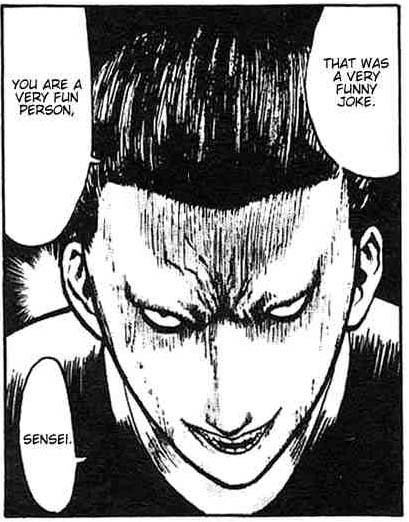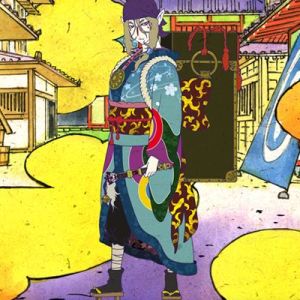The Good, The Bad, and the Lovely
Manga and Anime Reviews
by McCamy Taylor
 I would never waste the reader’s time writing about
bad manga. However, this month, I am going to spend
more time than usual discussing the art of graphic fiction. And I will
close with a couple of anime suggestions.
I would never waste the reader’s time writing about
bad manga. However, this month, I am going to spend
more time than usual discussing the art of graphic fiction. And I will
close with a couple of anime suggestions.
Before there was Claymore , Yagi Norihiro spent close to a
decade writing and drawing the 15 volume manga Angel Densetsu,
one of my all time favorites. While this series has not been licensed
in the United States, it has been translated and is available
online. The premise is simple enough. Seiichiro
Kitano has the heart of an angel---and the face of a demon. When he is
forced to change high schools, his appearance gets him into a load of
trouble. The school guardians (thugs) decide that he is a
threat to their authority and challenge him. The good guys----like
romantic interest, Ryoko Koiso, daughter of a karate
master---also want to kick his butt. While Kitano never throws a punch
in the entire 15 volume high school/martial arts manga, he has an
almost supernatural ability to defend himself through sheer endurance
and his incredibly scary demeanor.
This idea sounds like it would be good for about a volume before the
running gag gets old. However, Angel Densetsu works, because
Kitano really is an angel. A very likable, endearing angel, who
transforms the lives of those he encounters. Don’t
get me wrong. This is no “I will keep taking your punches
until you love me” Naruto type tale. The
stories are much more clever. The series is also incredibly
funny. Every chapter had me laughing out loud.
 Now, I like the art of Angel Densetsu . I think the mangaka
does a fine job of contrasting the creepiness of Kitano’s
appearance with his innocent nature. However, compared to
American comics and graphic fiction, which often emphasize drawing over
story, the quality of the art may seem lacking. So, I am
going to recommend another martial arts manga, one which is as
beautiful to look at as Angel Densetsu is plain.
Now, I like the art of Angel Densetsu . I think the mangaka
does a fine job of contrasting the creepiness of Kitano’s
appearance with his innocent nature. However, compared to
American comics and graphic fiction, which often emphasize drawing over
story, the quality of the art may seem lacking. So, I am
going to recommend another martial arts manga, one which is as
beautiful to look at as Angel Densetsu is plain.
Vagabond is licensed in the United States and is
widely available. The U.S. publisher has even begun to re-release the
series in jumbo size volumes, (each book includes several volumes)
which can help first time readers save money. An ongoing series at 30
volumes (29 of which are available in the United States) by Inoue
Takehiko, Vagabond tells the story of the historical
figure, Miyamoto Musashi, master swordsman and author of
The Book of the Five Rings . If you are in the mood for lots and
lots of historical Japanese fiction combined with sword
fighting and a dash of the supernatural, Vagabond is for
you. The story is first rate, with excellent pacing and
characterization. But what really sets this one apart is the quality of
the art, which would make many American comic artists jealous.
 Finally, as promised, I am going to spend a few minutes writing about
anime. Many Japanese animations are derived from manga. However, when a
work of Japanese graphic fiction is retold in animated form, it is
changed. Black and white illustrations become color on the TV or movie
screen. And the visual art suddenly becomes all important. A case in
point is the animated series Mushi-shi derived from the manga
of the same name which I reviewed last month.
Finally, as promised, I am going to spend a few minutes writing about
anime. Many Japanese animations are derived from manga. However, when a
work of Japanese graphic fiction is retold in animated form, it is
changed. Black and white illustrations become color on the TV or movie
screen. And the visual art suddenly becomes all important. A case in
point is the animated series Mushi-shi derived from the manga
of the same name which I reviewed last month.
While Mushi-shi the manga makes for good reading, if you like
imaginative fantasy, the 26 part animated series is a masterpiece. I
can not recommend it highly enough. The manga talks about the wonders
of the Japanese landscape, but the anime revels in it. You
will be tempted to freeze the DVD in order to study the
images, which are often as beautiful as a classic Japanese woodblock
print.
 Another fantasy anime series with unusually fine quality art is
Mononoke (not to be confused with Princess Mononoke
). A spin off of the last of the three stories from
Ayakashi: Samurai Horror Tales which has been licensed in the U.S.,
Mononoke is currently available only on fansubs.
Like Mushi-shi it is set in historical Japan and tells the
story of a wandering magician (referred to as the Medicine
Seller ) who is called upon to exorcise mononoke, or supernatural
monsters. He does this by investigating their shape, truth
and reason. Once he understands their nature, he can banish the spirits
with a supernatural anthropomorphic sword. The art used in this
animation is deliberately fantastic----in keeping with the nature of
the stories. Unlike Mushi-shi with its spare, classical
Japanese style, this anime draws heavily on a number of famous artistic
styles, such as that of Gustav Klimt. Good stories. Art like
you have never seen before in an animation.
Another fantasy anime series with unusually fine quality art is
Mononoke (not to be confused with Princess Mononoke
). A spin off of the last of the three stories from
Ayakashi: Samurai Horror Tales which has been licensed in the U.S.,
Mononoke is currently available only on fansubs.
Like Mushi-shi it is set in historical Japan and tells the
story of a wandering magician (referred to as the Medicine
Seller ) who is called upon to exorcise mononoke, or supernatural
monsters. He does this by investigating their shape, truth
and reason. Once he understands their nature, he can banish the spirits
with a supernatural anthropomorphic sword. The art used in this
animation is deliberately fantastic----in keeping with the nature of
the stories. Unlike Mushi-shi with its spare, classical
Japanese style, this anime draws heavily on a number of famous artistic
styles, such as that of Gustav Klimt. Good stories. Art like
you have never seen before in an animation.
© 2009 McCamy Taylor
Bio: McCamy Taylor is Aphelion's current Serials and Novellas Editor (if you have a story longer than 7,500 words, or long enough that it would be suitable for publication in two or more installments, she's your girl... er, woman), author of many short stories and longer fiction, here and in other publications, and is now Aphelion torchbearer for the cause of Japanese graphic novels and animation.
Comment on this story in the Aphelion Forum
Return to Aphelion's Index page.
|




